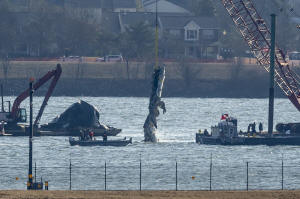NTSB finds Army chopper in fatal midair crash with plane was above
altitude limit
[July 31, 2025]
By JOSH FUNK
Incorrect altitude readings on the Army helicopter that collided with a
passenger plane over Washington, D.C., in January contributed to the
aircraft getting too close, but air traffic controllers warned about the
hazards helicopter traffic presented years before the crash.
Those warnings came even before the 85 near misses near the airport in
the three years before the crash. But despite the concerns that were
raised about the route the Black Hawk helicopter followed that night,
the Federal Aviation Administration didn’t make changes to it or warn
pilots about it.
The details came out of the first day of National Transportation Safety
Board hearings in Washington, where investigators highlighted several of
the factors that contributed to the crash between the American Airlines
plane from Wichita, Kansas, and the Black Hawk helicopter near Ronald
Reagan National Airport that was the deadliest aviation disaster in
America since November 2001.
“It’s so bureaucratic,” NTSB Chairwoman Jennifer Homendy said. “I mean
we heard it in the testimony today: ‘Oh you could bring it up in another
symposium or another group. or you could take this option or we said
no.’ But then I asked did you provide an alternative? That’s why people
are so critical of the federal government because you can’t ensure
safety.”
Representatives of the Army and Federal Aviation Administration tried to
deflect responsibility throughout the hearing. The Army acknowledged
that their Black Hawks altimeters might be more than 100 feet (30
meters) off, but they seemed to say that was acceptable because their
pilots’ goal is to maintain altitude within 100 feet of a limit.

Army officials instead raised concerns about the lack of separation
between landing aircraft and helicopters flying on approved FAA routes
near the airport. But later in the day, FAA and Army officials both
implied that those routes were never supposed to ensure separation.
Instead they suggested that it was up to the air traffic controller to
keep helicopters from flying on that route anytime planes were taking
off or landing from that runway.
Aviation lawyer Bob Clifford, who is representing several of the
victims’ families said there was a lot of “finger pointing” and “no
acceptance of responsibility and accountability” during the hearing.
The board’s final report won’t be released until sometime next year, but
it became clear Wednesday how small a margin of error there was for
helicopters flying the route the Black Hawk took the night of the crash.
The January nighttime incident was the first in a string of crashes and
near misses this year that have alarmed officials and the traveling
public, despite statistics that still show flying remains the safest
form of transportation.
Animation, altimeter discrepancy
A video animation showed where the helicopter and airliner were leading
up to the collision. It showed how the helicopter flew above the 200
feet (61 meters) altitude limit on the helicopter route along the
Potomac River before colliding with the plane.
Investigators said Wednesday the flight data recorder showed the
helicopter was actually 80 feet to 100 feet (24 to 30 meters) higher
than the barometric altimeter the pilots relied upon showed they were
flying. So the NTSB conducted tests on three other helicopters from the
same unit in a flight over the same area and found similar discrepancies
in their altimeters.
Dan Cooper with Sikorsky helicopters said that when the older Black Hawk
helicopter involved in the crash was designed in the 1970s, it used a
style of altimeter that was common at the time. Newer helicopters have
air data computers that help provide more accurate altitude readings.
Army Chief Warrant Officer Kylene Lewis told the board that she wouldn’t
find an 80 to 100 foot discrepancy between the different altimeters on a
helicopter alarming because at lower altitudes she would be relying more
on the radar altimeter than the barometric altimeter. Below 500 feet
(152 meters), Lewis said she would be checking both instruments and
cross referencing them, although that's not something every Army pilot
is trained to do.
Army officials said the greater concern is that the FAA approved routes
around Reagan airport that included such separation distances as small
as 75 feet between helicopters and planes when planes are landing on a
certain runway at Reagan.

“The fact that we have less than 500 foot separation is a concern for
me,” said Scott Rosengren, chief engineer in the office that manages the
Army’s utility helicopters.
But Rosengren said that “if he was king for a day” he would immediately
retire all the older Black Hawk models like the one involved in this
crash and replace them with newer versions of the helicopters.
Questions over the route
Army officials and the head of a local medevac helicopter company that
flies around Washington told the board they believed air traffic
controllers would never let them fly the helicopter route involved in
the crash anytime a plane was approaching the runway.
Chief Warrant Officer David Van Vetchen said after the crash that he
talked to many of his fellow pilots and everyone had the same assumption
that controllers would never allow them to fly across the path of the
runway the American plane was approaching before the crash. But Homendy
said other pilots in the unit told investigators they were allowed to
fly underneath landing planes.
[to top of second column]
|

A piece of wreckage is lifted from the water onto a salvage vessel
near the site in the Potomac River of a mid-air collision between an
American Airlines jet and a Black Hawk helicopter, at Ronald Reagan
Washington National Airport, Feb. 4, 2025, in Arlington, Va. (AP
Photo/Ben Curtis, file)

Citing the numbers for runways, Van Vetchen said that “100% of the time
when I was on route four and 33/15 was active” he would be instructed to
hold until after the plane landed or took off from that runway.
‘Stepped on transmission'
During the two minutes before the crash, one air traffic controller was
directing airport traffic and helicopters in the area, a task that
involved speaking to or receiving communications from several different
aircraft on two different frequencies, according to the NTSB’s History
of Flight Performance Study released Wednesday.
The air traffic controller had spoken to or received communications from
the Black Hawk helicopter, an airplane that was taking off, an Air Force
helicopter, an airplane on the ground, a medical helicopter and an
inbound flight that was not the American Airlines plane that would
crash.
“All aircraft could hear the controller, but helicopters could only hear
other helicopters on their frequency and airplanes only other
airplanes,” the report stated. “This resulted in a number of stepped on
transmissions as helicopters and airplanes were not aware when the other
was communicating.”
Stepped on transmissions are those that are unheard or blocked because
of other transmissions. The NTSB report provides a list of 29 separate
communications between the airport tower and other aircraft during
approximately the 1 minute and 57 seconds before the collision.
Previously disclosed air traffic control audio had the helicopter pilot
telling the controller twice that they saw the airplane and would avoid
it. Officials on Wednesday also raised the use of night vision goggles,
which limit the wearer's field of view, on the helicopter as a factor.
Investigations have already shown the FAA failed to recognize a
troubling history of 85 near misses around Ronald Reagan National
Airport in the years before the collision, and that the Army's
helicopters routinely flew around the nation's capital with a key piece
of locating equipment, known as ADS-B Out, turned off.
On Wednesday, it came out that even if they had been turned on, the
ADS-B Out systems on most of the helicopters in the same unit as the one
that crashed wouldn't work because they had been installed incorrectly.
When the NTSB uncovered that problem, the Army sent out an alert about
it and worked to quickly reprogram the units so they would work.

Homendy highlighted that an FAA working group raised concerns about all
the helicopter traffic around Reagan airport and the risk of a collision
in 2022, but the FAA refused to add a warning to helicopter charts
urging pilots to use caution when this runway was in use.
Homendy said “every sign was there that there was a safety risk and the
tower was telling you that.” But after the accident the FAA transferred
managers out of the tower instead of acknowledging that they had been
warned.
“What you did is you transferred people out instead of taking ownership
over the fact that everybody in FAA in the tower was saying there was a
problem,” Homendy said. “But you guys are pointing out, ‘Welp, our
bureaucratic process. Somebody should have brought it up at some other
symposium.’ Are you kidding me? 67 people are dead. How do you explain
that?”
Proposed changes
U.S. Sen. Ted Cruz, a Republican, introduced legislation Tuesday to
require all aircraft operators to use both forms of ADS-B, or Automatic
Dependent Surveillance Broadcast, the technology to broadcast aircraft
location data to other planes and air traffic controllers. Most aircraft
today are equipped with ADS-B Out equipment but the airlines would have
to add the more comprehensive ADS-B In technology to their planes.
The legislation would revoke an exemption on ADS-B transmission requests
for Department of Defense aircrafts.
Homendy said her agency has been recommending that move for decades
after several other crashes.
Transportation Secretary Sean Duffy said that while he’d like to discuss
“a few tweaks,” the legislation is “the right approach.” He also
suggested that the previous administration “was asleep at the wheel”
amid dozens of near-misses in the airspace around Washington's airspace.
___
Associated Press writers Leah Askarinam, Ben Finley and Rio Yamat
contributed to this story.
All contents © copyright 2025 Associated Press. All rights reserved
 |